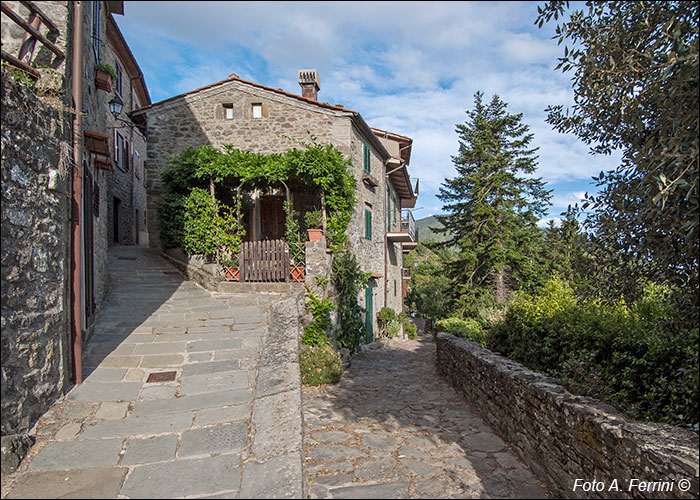Da un antico castello all’erboso crinale
itinerario sul Pratomagno valdarnese: da Trappola alla Bottigliana e alla Pozza Nera
Italiano
ITINERARIO TRAPPOLA – CIMA BOTTIGLIANA – POZZA NERA 4
Una strada interna (nella foto) percorre interamente il lungo e stretto borgo di Trappola. È un vero piacere camminarci osservando i panorami e quanto sono curate le case che la fiancheggiano. Lo sviluppo di Trappola come paese inizia a fine Cinquecento, quando la Famiglia Ricasoli divenne proprietaria di gran parte delle pendici valdarnesi del Pratomagno, un territorio che comprendeva anche Rocca Ricciarda, Poggio di Loro e Anciolina. Trappola doveva ingrandirsi per ospitare tutti quei boscaioli, carbonai, agricoltori, pastori, e le relative famiglie, che lavoravano in questa zona della montagna. Nel Trecento i Ricasoli erano già stati proprietari della zona, ma per pochi anni. Vediamo sinteticamente la storia. In data non conosciuta con precisione, i Guidi cedettero ai Pazzi del Valdarno il Castello di Trappola. Si sa che nel 1323 era già in possesso di questa potente famiglia perché fu in quell’anno che gli abitanti del castello si ribellarono per consegnarsi alla Repubblica Fiorentina. Con l’aiuto degli Ubertini di Soffena, i Pazzi si ripresero quasi subito il castello che qualche anno dopo passò agli Ubertini probabilmente per un’eredità. Questi, nel 1331, lo vendettero a Bindaccio di Albertano dei Ricasoli che aveva intrapreso una sorta di sfida con la Signoria di Firenze per il controllo del Valdarno. Alla morte di Bindaccio Firenze confiscò ai Ricasoli il territorio di Trappola, per poi restituirglielo un paio di secoli dopo come scritto nella pagina precedente. Trappola fu un vero e proprio feudo dei Ricasoli che detennero con il titolo di baroni fino alla metà del XVIII secolo quando gli fu tolto con i Lorena divenuti Granduchi di Toscana. La Famiglia Ricasoli rimase comunque proprietaria di molti beni in questo territorio fino ai primi decenni del XX secolo. An internal road (in the photo) runs entirely through the long and narrow village of Trappola. It is a real pleasure to walk there observing the views and how well-kept the houses that flank it are. The development of Trappola as a town began at the end of the sixteenth century, when the Ricasoli family became owners of a large part of the Valdarno slopes of Pratomagno, a territory that also included Rocca Ricciarda, Poggio di Loro and Anciolina. Trappola had to grow to accommodate all those woodcutters, charcoal burners, farmers, shepherds, and their families, who worked in this area of the mountain. In the fourteenth century the Ricasolis had already been owners of the area, but for a few years. Let's look at the story briefly. On a date not precisely known, the Guidi family ceded Trappola Castle to the Pazzi del Valdarno. It is known that in 1323 it was already in the possession of this powerful family because it was in that year that the inhabitants of the castle rebelled to hand themselves over to the Florentine Republic. With the help of the Ubertini of Soffena, the Pazzi almost immediately took back the castle which a few years later passed to the Ubertini probably through an inheritance. These, in 1331, sold it to Bindaccio di Albertano dei Ricasoli who had undertaken a sort of challenge with the Lordship of Florence for control of the Valdarno. Upon Bindaccio's death, Florence confiscated the territory of Trappola from the Ricasoli, only to return it to them a couple of centuries later as written on the previous page. Trappola was a real fiefdom of the Ricasolis which they held until the mid-18th century when it was taken from them when the Lorenas became Grand Dukes of Tuscany. However, the Ricasoli family remained the owner of many assets in this area until the first decades of the 20th century.




























































































